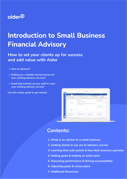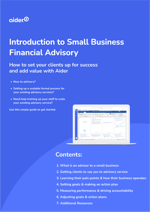Introduction to Small Business Financial Advisory
How to set your clients up for success & add value with Aider
Updated: 3 November 2023
- New to advisory?
- Setting up a scalable formal process for your existing advisory services?
- Need help training up your staff to scale your existing advisory services?
Use this simple guide to get started
You can also download this as a PDF eBook for internal training purposes.
Contents:
1. What is an advisor to a small business?
An advisor is someone who:
- Asks the right questions about their client’s operations
- Listens to their client’s pain points and helps them make a plan to address them
- Helps clients set long term goals and targets, and breaks these down into actionable monthly targets
- Measures their performance towards their goals
- Drives accountability and actions based on performance
2. Getting clients to say yes to advisory services
Getting your clients interested in value-add advisory services:
- Using the Aider Dashboard, sort across the financial categories to identify which clients need the most help/attention; as well as clients that are growing and may benefit from your advice to ensure sustainable growth.
- Introduce these clients to your monthly advisory service (if they don't already get this). Explain how this service can help them clarify their goals, track and align their operations to these goals, and ensure their business can thrive and grow.
- Once a client has accepted the new service proposal, set up a meeting to create a foundation for success by discussing what success looks like for them.
- During the meeting, discuss where they want their business to be in 5 years, and what's stopping them from getting there right now. Listen for insights about your client's business operations and the different aspects that make their business what it is.
3. Learning their pain points & how the business operates
List the immediate pain points.
For example:
- Cash flow management
- Setting money aside for taxes
- Staffing
- Sales process
- Profit
4. Setting goals & making an action plan
Create an action plan based on the pain points:
Identifying your client’s top pain points and looking into the details of these areas with your clients will reveal the steps required to overcome their challenges. Start with the pain points that have the biggest impact and devise a plan to set SMART goals across these areas.
To set SMART financial goals, discuss your client's vision for their future:
This could be related to buying a new house in 5 years, getting more time back to spend with family, or paying themselves more for all the hard work they’re doing. Whatever the goal is, work backward from it and identify the financial measures and milestones that will drive your clients toward these goals.
Start simple with a 1, 2, and/or 3-year plan.
For example:
Year 1 goal:
- My client wants to make $250k in Revenue and $150k in Profit next year
Action plan:
- Grow Revenue by 25% by creating a sales pipeline and setting monthly targets.
- Decrease Operating Expenses by 15% by assessing the top 10 expenses, and looking for cost reductions opportunities. Set a monthly OpEx target.
- Increase Profit by 40% as per above, and set a monthly target accordingly.
5. Measuring performance & driving accountability
The next step is measuring performance and holding your clients accountable every month to ensure progress is made in the right direction.
This is the bulk of your advisory activities.
How to use Aider to track, measure and help improve performance:
- Use the monthly report to measure your client’s performance, and provide accountability for their targets. Use previous period comparisons for context to help set achievable targets.
- Check across their cash flow, taxes, and profitability performances to diagnose the sources of any financial issues. Identify the best areas to focus on to improve their overall business performance.

You can use the monthly report’s AI-generated Executive Summary as a quick starting point for this analysis, and Advisory Assistant for further exploration and refinement. - Break down these financial performances into actions that your clients can take, so that they understand how to improve their situation.

You can use the monthly report’s AI-generated ‘Action Points for Improvements’ on the Executive Summary page as a quick starting point for this analysis. - Make sure the actions are not overwhelming. Prioritise and limit the areas to work on to a maximum of 3 per month.
6. Adjusting goals & action plans
Regularly check with the client to see whether their goals, pain points and operations have changed as new opportunities and challenges arise.
If they have:
- Repeat steps 3 (learning) and 4 (goal setting and action planning).
- Adjust step 5 (measurement) accordingly.
Want to share with your colleagues?
Download this guide as a PDF >

